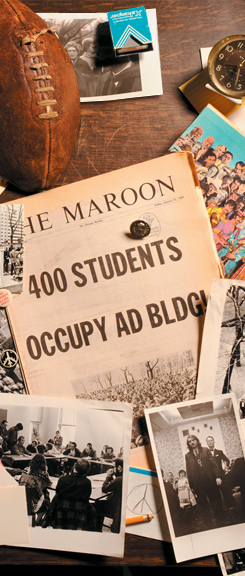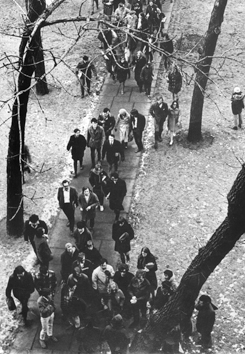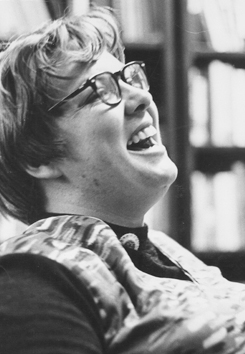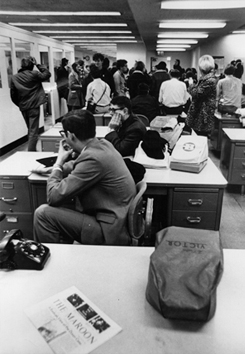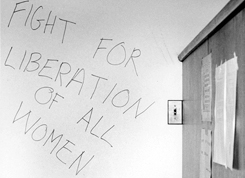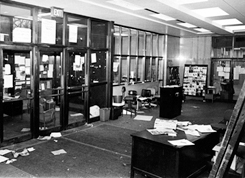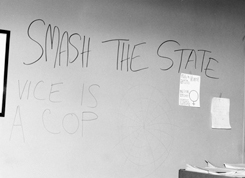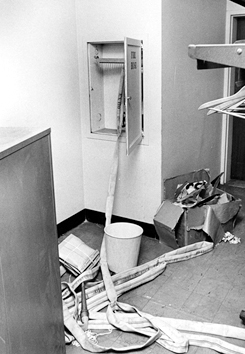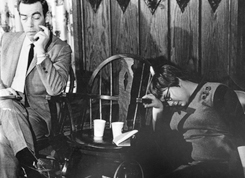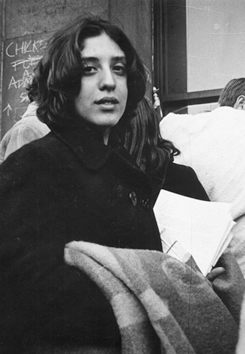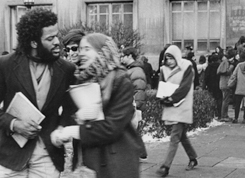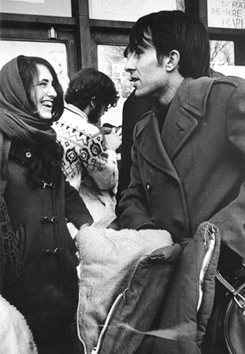Which side are you on?
A look back at the sit-in of the Administration Building in 1969
This is an extended version of the original Core article.
In the print version of the Core, these photographs ran without attribution. The editors regret the oversight. —Ed.
By Carrie Golus, AB'91, AM'93
Photographs courtesy of the Chicago Maroon and Special Collections
On January 10, 1969, the Chicago Maroon got a redesign. The entire front cover was given over to an aerial photo of the main quad, the traffic circle an enormous empty-set sign in the snow. “Because ‘news’ is so sporadic on this campus,” a letter from the editor explained on page six, “and because we only come out twice a week, it doesn’t make much sense to keep trying to have banner headlines and news front pages. So instead we will try to have good-looking front pages and put the news on the inside.”
An odd decision, given how turbulent 1968–69 had already been. In October, students held a “tent-in” on the quad to protest the lack of adequate housing. In November, 100 students demonstrated outside the inauguration of University president Edward Levi; inside at the formal dinner, protesters repeatedly interrupted the speakers, while guests retaliated by kicking the protesters or dousing them with glasses of water.
And just three days before the snowy-photo cover, the story of the year broke: Marlene Dixon, a popular assistant professor in human development and sociology, had not had her contract renewed. The Committee on Human Development voted for renewal, but the Department of Sociology voted for denial, and its recommendation held. The sociology department would not give a reason, but the Maroon made its inference clear, describing Dixon as someone “who marched out of line at November 14’s inauguration procession to stand vigil with student demonstrators.”
Within days, students began to mobilize. Pickets and petitions were organized. Demands for an open meeting with sociology professors were made. A so-called “Committee of 75”—named for 75 undergraduate and graduate students who had attended an early meeting—sent a letter to the Maroon stating they could “only surmise that Mrs. Dixon’s contract was not renewed for the following reasons”: her leftist politics, “radical” version of sociology, emphasis on teaching rather than publications, and gender. (At the time there were fewer than ten tenured women faculty members.)
Initially, Dixon kept her silence, but soon enough gave a talk at the Blue Gargoyle and an interview to the Maroon, headlined “Marlene Dixon Speaks Out Her Truth”: “I increasingly realized that I couldn’t stop being a radical in the classroom, and that furthermore I didn’t believe in value-free sociology,” she said.
“…[C]areerism and scholarship are very difficult to combine.…If you really want to be committed to a different university, or a different form of your discipline, you have to be prepared to become a kind of academic dropout,” she said. “That was a very difficult decision for me, and I think I decided to pay the price.”
While much of the debate about Dixon was serious, if impassioned, pranksterism came into it too. One afternoon, eight women from the student group WITCH (Women’s International Terror Conspiracy from Hell) burst into the sociology tea room and put a hex on sociology chair Morris Janowitz: “Beware of the curse, the witch’s curse, Morris Janowitz of sociology, a hex upon thy strategy,” they chanted. “Women enraged with this denial come in black to demand a trial, not of Mrs. Dixon but of yourself: such arrogance from such an elf.” Unfortunately for the WITCHes, Janowitz was not there. They tried cursing him near a room where he was scheduled to teach, but he wasn’t there either.
Meanwhile, not to lose sight of the national scene, the U of C group Students for Violent Non-Action called for every possible toilet in America to be flushed when President Richard Nixon delivered the final word of his inaugural oath on January 20.
In the spring of 1969, John Boyer, AM’69, PhD’75, now dean of the College and professor of history, was a first-year graduate student. He had considered attending Columbia but was deterred by the militant student actions there. “I had to make up my mind in April 1968,” he says, “when the big student disruptions occurred on Columbia’s Morningside Heights campus. Since it was not clear to me, or anyone else, what was going to happen the following autumn, I opted to accept the University of Chicago’s offer.”
Thirty years later, Boyer published a monograph about the era, The University of Chicago in the 1960s and 1970s. The Dixon case, he wrote, “allowed radical students to galvanize support” among a broad range of students, “as if a providential historical materialism had intervened.” It sounds like a historian’s reassessment, but evidently students were aware of this even at the time: “After a very quiet quarter,” the editorial board of the Maroon wrote on January 17, “in which the administration prided itself on how well it was handling the ‘student problem,’ and the radicals stamped around looking for an issue, the campus is beginning to move again.”
“With all due respect to Marlene Dixon,” says Jeff Blum, X’68, one of the leaders of the sit-in, “she was just an excuse.” Student protesters were angry about the Vietnam War, the University’s treatment of the surrounding community, and racism and sexism. “As Mark Rudd put it so well,” Blum said (Rudd had led the takeover of buildings at Columbia and later joined the terrorist group the Weather Underground), “‘the issue is not the issue.’”
As January wore on, cold and snowy, the debate grew more and more heated. A faculty committee, chaired by then-associate professor of history Hanna Gray (later president of the University) was appointed to investigate the Dixon decision. Its seven members included two other women: Helen H. Perlman from the School of Social Service Administration and Susanne Rudolph from political science. D. Gale Johnson, dean of the graduate Social Sciences Division, told the Maroon that he had specifically requested so many women members.
But that did not appease Dixon’s supporters. “How can an unbiased judgment be expected from a committee formed from a University which claims to be a bastion of pure, value-free, uncorrupted, ivory tower thought, yet which allies itself with the war machine and acts as an agent of social repression to the black ghetto?” Steve Rothkrug, X’70, wrote in the Maroon.
Sociology faculty agreed to a meeting to discuss hiring in general but walked out when students demanded to discuss Dixon specifically. The following week, 150 students broke into Johnson’s locked office at lunchtime. For two hours, Johnson sat in his chair and coolly answered questions, though “I didn’t get much chance to speak after the first hour,” he told the Maroon. In the outer office, Janowitz argued with protesters while standing on a table.
Meanwhile, the Maroon conducted a survey of 70 students who had taken classes with Dixon over the previous two years. Sixty students said she was a good teacher: “She’s the only teacher I’ve had who is totally human,” said one. “The only thing extreme about her was her real enthusiasm,” said another. Five students were not so sure, while five more said she was not a good teacher, claiming she was “much overrated” or “doesn’t know her stuff.”
On Wednesday, January 29, 1,200 students packed Mandel Hall. After a very close vote—444–430—the students decided to take militant action. At another meeting later that night in Kent, the Admin Building was chosen as the target; Cobb Hall was rejected on the basis that the group did not want to alienate unsympathetic students. “Our plan was to try to bring the University to a screeching halt,” says Blum. “At 62 years old, I’m not going to say I think that was a brilliant plan.”
At noon the following day, the protesters, now renamed the Committee of 444, entered the building. But according to Martin Northway, X’70, they nearly didn’t. Disapproving of the protesters’ tactics—and worried that student-aid checks would not be available if the bursar’s office were closed—football player Northway and about 20 other athletes stood shoulder to shoulder in front of the doors, blocking the protesters from entering. “We didn’t threaten anybody, we didn’t look ferocious, we were just standing there,” Northway says. Two or three times, he says, the protesters tried to lead a surge into the building and were quietly repelled.
Then one of his fraternity brothers wandered by and pointed out that it was nearly lunchtime at the house. “For a few sacks of hamburgers, maybe the University could have prevented the whole situation,” Northway says. The athletes left, and the Maroon finally had its front-page story: “400 STUDENTS OCCUPY AD BLDG!”
The administration was ready. Private offices were locked, and all phones in the building were shut off, including the pay phones. One employee in the public-information office left a sign reading, “Sit-inners: Water my plants if you’re here Friday. They’ve already been watered Thursday.” At 12:30, Charles O’Connell, AM’47, dean of students, gave the protesters a disciplinary warning and a deadline of ten minutes to leave. When the deadline came and went, a group of administrators passed out summonses to appear before a disciplinary committee. At least one student burned the summons.
The students were ready too. They brought in large stores of food, and “most of the students were dressed in jeans and other casual clothes,” the Maroon noted, “as if ready for a long stay.” About a dozen student marshals, wearing white armbands, circulated throughout the building to keep order.
Night came, then the next day, and the next. The protesters—whose numbers quickly dropped to about 175—waited to see how the administration was going to respond. They ate peanut-butter and jelly sandwiches, held meetings, and waited some more. “We slept on top of filing cabinets or in between them,” Blum says. “Some floors had carpeting—that was very choice. I don’t think we cared very much about creature comforts. We felt like we were on the front lines of something.”
“The University’s reaction was a very sane one. They just ignored us,” says Jeff Maso, X’69, who was on building security. “They regarded us like the flu: in a couple of weeks, this will go away, and we’ll all feel better.” Meanwhile the Maroon returned to its old format and started publishing daily.
Discipline cracked down quickly, in the very earliest days of the sit-in. On February 3, a disciplinary committee chaired by Dallin H. Oaks, professor at the Law School, temporarily suspended 61 students for participating in a “disruptive demonstration” until the charges could be resolved.
“The sticky wicket for me,” says David Bevington, professor of English, “was that somebody had to identify students. I was in and out of the Administration Building all the time, and I was not about to do this.” In two previous sit-ins of the Admin Building, in 1966 and 1967, demonstrators had willingly given their names. (Both were protests against the University’s policy of releasing the academic records of male students to their draft boards.) But during the 1969 sit-in, protesters did not cooperate.
For Richard Flacks, assistant professor of sociology and, like Dixon, a well-known leftist, the willingness of faculty to name names was one reason why he left the University at the end of the year. “The University prided itself on strong mentoring,” he says. “Who could faculty identify, but their very own students, the ones they knew best? It was both poignant and disturbing as hell.”
For other faculty members, such as Herman Sinaiko, AB’47, PhD’61, professor of humanities, the students’ decision to remain anonymous was just as troubling. When a group of his students invited him into the building, he decided to teach a class on Plato’s Crito. The dialogue turns on whether Crito’s plan to help Socrates escape from prison would be just. “Socrates is quite clear that he thinks he was unjustly sentenced to death, but that’s not the issue. The issue is, what does he do?” Sinaiko says. “I was concerned about whether the kids had thought seriously about what they were doing and how they were doing it.”
Meanwhile, similar concerns about justice were leveled at the Oaks committee. More than 150 members of the Law School and its faculty signed a petition objecting to the proceedings, the Maroon reported, because of a lack of due process. The committee had four student observers, including Mary Leighton, AB’69. After three weeks, Leighton and two of the other student observers resigned. “I remember thinking, these are decent people trying to figure out what’s right,” Leighton says. “But they were just clueless.”
Although the sit-inners confined their disruption to the Admin Building, the Chickenshit Theater Brigade, a guerilla theater group, was disruptive all over campus. During the disciplinary hearings, for example, Terry Curtis Fox, AB’70, read aloud from the trial scene from Catch-22. Other members hopped around like kangaroos. Explaining the group’s name and philosophy, Fox wrote in the Grey City Journal, “There is no doubt that sheer and utter fear was one of the main factors in the band’s formation.”
“You have to remember that anyone who lost their student status, their 2-F, was subject to the draft,” Fox says. “I wasn’t doing anything that was beyond the bounds of annoyance. No one could be kicked out for being an annoyance.” At that, the group definitely succeeded: “If you had thought for days and nights for the best way for nothing to be done, you couldn’t have come up with anything better than the Chickenshits,” Wayne Booth, AM’47, PhD’50, dean of the College, told the Maroon at the time.
On February 4, 30 Chickenshits barricaded a group of administrators, including President Edward Levi, inside the Quad Club. According to the Maroon, they marched around the building tooting kazoos, singing, tapping on windows, and chanting “61,” the number of suspended students. When the administrators finally emerged, they had to push their way through the chanting crowd. On the way out, Levi’s brother, Julian Levi, PhB’29, JD’31, professor of urban studies and executive director of the Southeast Chicago Commission, pointed his pipe at several students and shouted, “You’re 62, you’re 63, you’re 64….” When a protester suggested they just wanted to talk, he shot back, “Look, do me a favor, forget two words— ‘relevant’ and ‘dialogue.’”
Among the professors, just one took a similarly light-hearted approach: under a pseudonym, Richard Stern published a satirical poem, “The Marleniad,” to the Maroon. “My poem was adolescent, maybe even cruel,” he recalls. “Did I know Marlene Dixon? I never laid eyes on her.” Sit-in leaders Chris Hobson and Howie Machtinger (later a founding member of the Weather Underground) wrote a one-sentence letter to the Maroon in response: “John Donne would have beat the shit out of him.”
As the sit-in began its second week, criticism increased. On February 7, a group of 300 students held a rally against it. And a formal survey of students—printed in the Maroon, but copyrighted by its authors, William Ouchi and Ellen Fried—showed that a majority opposed the sit-in, though they also supported amnesty for the protesters.
Senior professors wrote devastatingly critical letters to the Maroon: “To condone these tactics, explicitly or implicitly, is to cooperate willingly in the destruction of the very foundation of our University,” wrote Milton Friedman. Bruno Bettelheim’s analysis was even starker: “The historical parallels between what is happening here and what happened in the German universities before Hitler are unfortunately relevant.”
But for Sinaiko, that comparison is inaccurate. As the sit-in began to lose momentum, Sinaiko attended an open meeting at the Oriental Institute, where the protesters were discussing strategy. Someone at the meeting—“clearly one of the more radical types,” he recalled—argued they should take over the library’s rare-book room and burn one book an hour until the University met their demands.
“Then a very, very interesting thing happened,” Sinaiko recalled. “There was an explosion of rage. The students stood up as one and said, ‘Throw that son of a bitch out! Who does he think we are, SS men? We’re thugs? We’re bums?’ There was almost a total unanimity of opinion that as members of the University, there were things they were not going to do. Burning a rare book was one of them.”
If students were not willing to resort to violence, neither was President Levi, who waited out the protest and—with good reason, given what had happened at the Democratic National Convention—refused to call in the Chicago police. “I suppose if there were a hero, it would be Edward Levi, who was a Hamlet-like figure here,” Richard Stern recalled. “He just knew there were certain things that you didn’t do. But he didn’t know what you did do.”
On Feburary 12, the Gray committee announced its decision. Dixon was offered a one-year contract in human development, which she promptly declined. With no cause left to fight, the protesters left the Admin Building on February 14. Now the focus of the students’ dissatisfaction shifted to the disciplinary committee.
On February 24, 100 students gathered at Levi’s house with a petition demanding that the committee accept a collective defense. As Maso recalled, the group’s plan was to nail the demands on the door in imitation of Martin Luther. They pounded on doors and windows until a female student managed to kick in a window. When campus police dispersed the crowd, 70 students marched to the Quad Club, where Maso, who worked there as a junior bartender, let them in.
According to a historical account by Boyer, “they taunted guests who were eating, took food and wine from the tables, cursed various faculty members in the room, and held mock meetings.” A Maroon article a few days after the event claims the demonstrators munched only crackers. One long-standing, unsubstantiated story is that professors’ ties were dipped in their soup. “Ties dipped in soup, huh? Well, there’s a capital offense,” said Maso, who does not recall if it happened or not. “I’m sure whoever’s tie got dipped, he was probably terrorized by that.”
After half an hour, the protesters voted to leave—after taking up a collection for the wait staff. Dean of Students Charles O’Connell, AM’47, told the Maroon the protest was “the most mindless, the most senseless, and the most child-like behavior” he had ever seen on campus. The demonstration resulted in nothing but an additional disciplinary committee—this one chaired by Charles Shireman of the School of Social Service Administration.
On February 28, Maso led another protest at the Quad Club. Blowing a shofar, he led the demonstrators around the building seven times, chanting “amnesty now” and “walls fall down.” The group retreated across the street to watch the building collapse, but, as the Maroon noted without further comment, “it did not.”
Meanwhile, the athletes were achieving much more success in their own countercultural cause: the return of varsity football. Northway remembers collecting signatures at Hutch Commons: “I got brushed off a few times,” he says. “But people weren’t in a particularly confrontational mood. It might have been protest overload.”
As winter turned to spring, the suspensions and expulsions began to mount. By April 1, the Maroon reported, of the 164 students summoned before the two disciplinary committees, 62 had been suspended and 37 expelled.
The uneven application of discipline provoked more dismay. “Students who were willing to say they made a mistake were not disciplined,” Flacks says. “Those who claimed their position had some validity were suspended or expelled. It didn’t foster a moral stance on the part of the students.”
Like the sit-in, the discipline that was meted out exposed generational divisions within the faculty. A group of 64 professors—including Paul Sally of mathematics, Ralph Austen of history, and Janel Mueller of English—signed a petition demanding no disciplinary action until a committee had been appointed that adhered to the guidelines of the American Association of University Professors. These guidelines required that committees should include students—not just as observers—and that violations had to be published in advance in a student handbook.
Parents also stepped in. At the end of March, a committee of parents took out a quarter-page ad in the Sunday New York Times. Headlined “OVERKILL at the University of Chicago,” the ad claimed that “Chicago has just expelled more dissenting students than Columbia, Berkeley, and San Francisco State combined.” In Flacks’s view, it amounted to “the biggest political purge in higher education during the 1960s.”
On April 9 and 10, protest leaders, now calling themselves the Committee of 500, organized a strike of classes at Cobb Hall, described by the Maroon as “about 70 percent effective.” At noon on April 9, there were fewer than 100 students in the building. Sympathetic professors either canceled their classes or held them elsewhere.
The faculty also held demonstrations: an hour-long, silent vigil outside the Admin Building on April 14 and another outside the Quad Club on May 6. Sally and two other faculty members appeared before the Council of the Senate to argue the disciplined students’ case, to no avail.
By mid-April, frustration had reached such a point that even a group of self-described “moderate” students took the dramatic step of staging a hunger strike. In the Maroon, leaders Sara Heller, AB’69, and Mary Leighton, AB’69, (one of the students who had resigned from the Oaks committee) published a letter addressed “To all the Espousers of the Great Liberal Tradition” criticizing the disciplinary procedures, and asking why measures such as fines were not considered. “However, because we still hope to graduate in June,” they wrote, “we feel constrained to continue to attend classes and keep up with our work as best we can.”
On Tuesday, April 15, seven students moved into tents on the quads, and over the next few days—despite thunderstorms and leaky tents—the number grew to 14. The strikers had agreed to consume only orange juice, water, and vitamins; one student chose to drink only water. “It was probably the most theatrical thing I ever did,” Leighton says.
For many of the administrators at the center of the dispute, the sight of young people going hungry was too much. “I wish to gosh they’d eat something,” Edward Rosenheim, professor of English and spokesman for the Committee of the Council, told the Maroon. Dean O’Connell had a similarly fatherly reaction. During a Maroon interview while it was thundering outside, he “repeatedly peered out his window…and expressed concern for the health of the strikers.” He said he had thought about asking his wife to bring the strikers bowls of chicken soup but had decided against it.
On April 21, the Committee of the Council agreed to meet with the group’s leaders, but the meeting did not go well. “When we protested the Oaks and Shireman committees had been unfair,” the strikers wrote in a statement issued afterward, “we were greeted with looks of incredulity.”
The following day, Dean Booth stopped by to talk. “He spoke with us so sympathetically,” hunger striker Susan (then Loth) Wolkerstorfer told the Maroon, “and then when he left he said, ‘Well, if there’s anything I can do for you short of giving you want you want, let me know.’” After nine days of fasting, the discouraged strikers gave up.
In human memory, 40 years is a long time. Perhaps surprisingly, the students’ memories seem to have faded more than their professors’. “I don’t know how well I remember the sit-in,” says Maso. “Many of my memories are visual. I always am suspicious when my memories are visual, because it suggests that some time afterward I saw a photograph. As it was happening, it was all pretty intense.”
“It’s like that whole period occurred in very bright light, and life since has been lived under a 60-watt bulb. It was too bright to be able to see detail,” reflects Blum. “And we didn’t get much sleep.”
“1968 was so vivid,” says Northway, encompassing the assassinations of Martin Luther King and Robert Kennedy, police brutality at the Democratic National Convention in Chicago, and the election of Richard Nixon. “By the beginning of 1969, people were just shell-shocked. It was a little bit like civilian PTSD or something.”
“To be brutally honest—and this is a conclusion I came to 30 years ago—we were wrong,” says Fox. “The sit-in against the rank was justifiable. That had a national effect. But in this case, we just supported the wrong person. I think when you realize you’re wrong, your memory isn’t as sharp. You suppress your own stupidity.”
Dixon taught at McGill University for a few years, where her stay was similarly contentious. Abandoning academia, she founded a radical political group, the Democratic Workers Party. The group was later denounced in a book, Bounded Choice: True Believers and Charismatic Cults, written by a former follower. Dixon recently died. “She became a dismaying figure afterward,” says Flacks. “But we don’t know what would have happened if she had continued on a normal career path. It’s hard to reimagine.”
As a result of the student unrest in 1968–69, the administration made some small changes to give students a stronger voice in University policy making. There is now a student ombudsman, and student evaluations are taken into consideration in tenure decisions. (Students with political concerns beyond the campus continue to struggle to have their concerns heard: in recent years, protests against investment in Sudan and against selling Coca-Cola on campus have failed. As a Maroon headline in the 2009 Orientation issue put it: “Campus controversies: the debates students will lose this year.”) In perhaps the biggest change to undergraduate life after 1968–69—“You’re kidding,” says Maso, when first informed 40 years after the fact—varsity football returned the following fall.
Some alumni of the late 1960s and early 1970s left with bitterness, but with time, that too had faded. In 2008, Blum chose to attend his reunion and was a panelist on a discussion about the era. Hunger-striker Wolkerstorfer is at the other end of the scale, having volunteered to interview prospective College students for more than 30 years. Her encounter with Booth during the strike could be seen as disheartening, but she does not remember it that way: “I was standing up for what I believed in,” she says. “I could respect that he was standing up for what he believed in.”
